Our Lady of Perpetual Help
Our Lady of Perpetual Help (also known as Our Lady of Perpetual Succour)[Note 1] is a Roman Catholic title of the Blessed Virgin Mary as represented in a celebrated 15th-century Byzantine icon also associated with the same Marian apparition.
| Our Mother of Perpetual Help | |
|---|---|
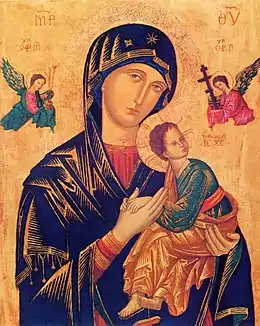 | |
| Location | Esquiline Hill, Rome, Italy |
| Date | Before 1499 |
| Type | Icon of Cretan School, Theotokos |
| Approval | Pope Pius IX |
| Shrine | Saint Alphonsus di Liguouri Shrine Our Mother of Perpetual Help Parish, Cabanatuan City |
| Patronage | • Redemptorist Order • Haiti • Almoradi, Spain; • Roman Catholic Diocese of Cabanatuan, Philippines; Roman Catholic Diocese of Leeds |
The icon originated from the Keras Kardiotissas Monastery and has been in Rome since 1499. Today it is permanently enshrined in the Church of Saint Alphonsus, where the official Novena to Our Mother of Perpetual Help text is prayed weekly.
On 23 June 1867, Pope Pius IX granted the image its Canonical Coronation along with its present title. The Redemptorist Congregation of priests and brothers are the only religious order currently entrusted by the Holy See to protect and propagate a Marian religious work of art. In the Eastern Orthodox Church iconography, the image is known as the ”Virgin Theotokos of the Passion” due to the instruments of the Passion of Jesus Christ present on the image.
Novena devotions are held before June 27 every year. Under Pope Pius XII's Pontificate, the image was designated as the national Patroness of the Republic of Haiti and of Almoradí, in the Valencian Country, Spain.
Due to promotion by the Redemptorist Priests since 1865, the image has become very popular among Roman Catholics. Modern reproductions are oftentimes displayed in residential homes, commercial establishments, and public transportation.
Description
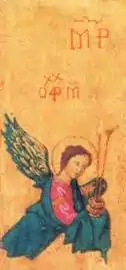
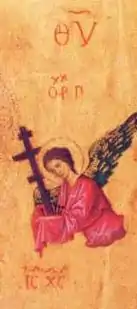
The original wooden icon is suspended on the altar, measures 17" × 21" inches and is written on hard nut wood with a gold leaf background.[1] The image depicts the following symbols:
- The Blessed Virgin Mary — wearing a dress of dark red, in Byzantine iconography the color of the empress, the Queen.[2]
- The subject shows Mary looking towards the faithful, while pointing at her son, Jesus Christ who is frightened by the instruments of crucifixion and is depicted with a fallen sandal.
- The left side is Saint Michael Archangel — carrying the lance and sponge of the crucifixion of Jesus.
- On the right side is Saint Gabriel Archangel carrying a 3-bar cross and nails.
- The Virgin Mary has a star on her forehead signifying her role as Star of the Sea while the cross on the side has been claimed as referring to the Greek monastery which produced the icon.
| Part of a series on the |
| Mariology of the Catholic Church |
|---|
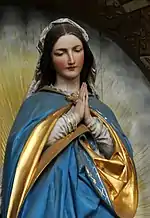 |
|
|
Byzantine depictions of the Blessed Virgin Mary in art have three stars, one star each on the shoulder and one on the forehead. This type of icon is called Hodegetria, where Mary is pointing to her Son, known as a Theotokos of the Passion.[3]
Mary has long slender nose, thin lips, and smoothly arched eyebrows, evidence of being made by a Greek artist. The veil and her face itself are rounded, indicating holiness. The size of the mother is also out of proportion to her son, a deliberate intent by the artist to show Mary as larger than life.
The Greek inscriptions read MP-ΘΥ (Μήτηρ Θεοῦ, Mother of God), ΟΑΜ (Ὁ Ἀρχάγγελος Μιχαήλ, Michael the Archangel), ΟΑΓ (Ὁ Ἀρχάγγελος Γαβριήλ, Gabriel the Archangel) and IC-XC (Ἰησοῦς Χριστός, Jesus Christ), respectively.
The icon has a gold background on a walnut panel, believed to be from Crete.[4] The Cretan School was the source of the many icons imported into Europe from the late Middle Ages through the Renaissance. The gold background represents the Kingdom of God.[5] The round halo surrounding the Virgin Mary's head as well as details on the robes were created through Estofado, which is an artistic effect created by scraping the paint to reveal the gold background, additional effects are achieved by chasing designs on the gold. The icon was cleaned and restored once in 1866 and again in the year 1940.
Origin and discovery
The icon is sometimes regarded to have been painted by Saint Luke the Evangelist or as a copy of the original Hodegetria. This association is rather weak in comparison to other icons such as the Salus Populi Romani and the Black Madonna of Częstochowa.
According to the tradition as published by the Keras Kardiotissas Monastery, the icon was painted by Saint Lazarus Zographos and was known as the Panagia Kardiotissa (Παναγίας Καρδιώτισσας), due to the depiction of the Mother of God holding the Christ Child to her heart. Historian Stergios Spanakis had argued that the miraculous icon was the reason for the founding of the monastery.[6] Cristoforo Buondelmonti, an Italian Franciscan priest and traveler who visited Crete in 1415, wrote of the icon being miraculous: "Βαδίζαµε ανάµεσα σε πυκνοδασωµένα πετρώδη βουνά µέχρι που φθάσαµε στην εκκλησία της Καρδιώτισσας, που πολλές φορές είχε φανερωθή στους πιστούς µε θαύµατα." The icon was stolen from the monastery in 1498.[7][8]
The earliest written account of the icon after its abduction comes from a Latin and Italian plaque placed in the church of San Matteo in Via Merulana where it was first venerated by the public in 1499. The writer of the icon is unknown, but according to a parchment attached to the painting that accompanied the icon, it was stolen by a merchant sailing to Rome from the island of Crete. (The Keras Kardiotissas Monastery is regarded as the monastery from which the icon was stolen.)[9] The image remained in the private possession of a Roman merchant and his family until 27 March 1499, when the icon was transferred to the church of San Matteo[10] where it remained for 300 years. The picture was then popularly called the Madonna di San Matteo.
The Redemptorists, (The Congregation of the Most Holy Redeemer) a congregation within the Roman Catholic Church, maintain a robust account of the icon and its passage from the private hands of a merchant family in Rome to its final and current location at the Church of St. Alphonsus De Liguori, on the Esquiline Hill in Rome.[11] The accounting includes the story of a merchant who secured the icon from Crete, and brought it to his family's home in Rome, during the late 15th century. The story includes a passage of a young member of the family, the six-year-old daughter of the merchant, who was visited by the Virgin Mary in a dream. Part of the accounting includes the following passage:
At last, the Blessed Virgin appeared to the six-year-old daughter of this Roman family and told her to tell her mother and grandmother that the picture of Holy Mary of Perpetual Help should be placed in the Church of St. Matthew the Apostle, located between the basilicas of St. Mary Major and St. John Lateran.[11]
The family delivered the icon to the church.
The icon remained at St. Matthew's for three centuries. For at least the final 60 years of the 18th century, St. Matthew's was occupied by an Irish Augustinian congregation of the Catholic Church. When war broke out in Rome in 1798, the icon was moved to the Church of St. Mary in Posterula, near the "Umberto I" bridge that crosses the Tiber River in Rome. The icon remained "hidden" there until Pope Pius IX granted the possession of the icon to the Redemptorists by Papal Edict, in 1865.[11] The Church of St. Mary in Posterula was later demolished in 1880.
According to the account by the Redemptorists: "In January 1866, Fathers Michael Marchi and Ernest Bresciani went to St. Mary's in Posterula to receive the picture from the Augustinians.".[11] The Redemptorists had purchased the property where the former St. Matthew's had stood, and had established and built the current Church of St. Alphonsus De Liguori, in honor of the founder of their congregation. Thus, the venerated icon of the Catholic Church was returned to the location described by the Virgin Mary in the dream of the merchant's daughter, that is, at the church between St. Mary Major and St. John Lateran.
Redemptorist tradition holds that Pope Pius IX declared, in 1866, that the Redemptorists make the icon known to the world, and so, several copies were made and sent to Redemptorist parishes around the world. One such Redemptorist parish in the United States, St. Mary's in Annapolis, Maryland, received a copy from Rome in 1868.[12] The image is prominently displayed within the sanctuary of the parish.
Transfer
In 1798, French troops under Louis-Alexandre Berthier occupied Rome as part of the French Revolutionary Wars, establishing the short-lived Roman Republic and taking Pope Pius VI prisoner. Among the several churches demolished during the French occupation was San Matteo in Via Merulana, which housed the icon.[13] The Augustinian friars who rescued the icon first took it to the nearby Church of St. Eusebius, then later set it up on a side altar in the Church of Santa Maria in Posterula.
In January 1855, the Redemptorist priests purchased Villa Caserta in Rome along the Via Merulana and converted it into their headquarters. Decades later, Pope Pius IX invited the Redemptorist Fathers to set up a Marian house of veneration in Rome, in response to which the Redemptorists built the Church of St. Alphonsus Liguori at that location.[2] The Redemptorists were thus established on the Via Merulana, not knowing that it had once been the site of the Church of San Matteo and shrine of the once-famous icon.
Present caretaker
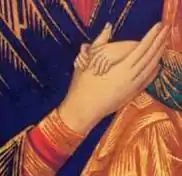
Pope Pius IX sent a letter dated 11 December 1865 to Father General Mauron, C.Ss.R., ordered that the image be once again publicly venerated in Via Merulana, the new church of Saint Alphonsus. The same Pontiff directed the Augustinian friars to surrender the icon to the Redemptorist priests, on condition that the Redemptorists must supply the Augustinians with another picture of Our Lady of Perpetual Help or a good copy of the icon in exchange as a gesture of goodwill. Pope Pius IX instructions to the Redemptorists were:
The Cardinal Prefect of Propaganda will call the Superior of the community of Sancta Maria in Posterula and will tell him that it is Our desire that the image of Most Holy Mary, referred to in this petition, be again placed between Saint John and Saint Mary Major; the Redemptorists shall replace it with another adequate picture.[14]
Upon its official transfer, Pope Pius IX finally gave his Apostolic Blessing and titled the icon Mater de Perpetuo Succursu (Mother of Perpetual Help). Two years later, on 23 June 1867, the image was given a Canonical Coronation by the Dean of the Vatican Chapter in a solemn and official recognition of the Marian icon under that title.
On 21 April 1866, the Redemptorist Superior General gave one of the first copies of the icon to Pope Pius IX. This copy is preserved in the chapel of the Redemptorists' Generalate in Rome. The original icon remains under the care of the Redemptorist Fathers at the Church of St. Alphonsus with the latest restoration of the icon having taken place in 1990.[14]
Restoration
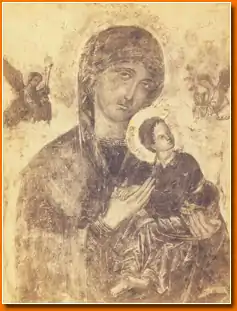
In 1866, the icon underwent restoration by the Polish painter Leopold Nowotny (1822-1870).[15]
In 1990, the icon was taken down from its altar for new photography and image restoration commissioned by the General Government of Redemptorists. The Redemptorist Order entered into contract with the Technical Department at the Vatican Museum to restore the icon and prevent further fungal damage to the icon. The restoration process involved X-ray, infra-red scanning, technical analysis of the paint and ultra-violet testing along with a Carbon-14-test which placed the icon between the year 1325-1480. Artistic analysis of the icon revealed that the facial structure of the icon was altered due to previous overpainting, resulting in a combination of "oriental and occidental" features of the image.[16]
Veneration
Our Lady of Perpetual Help has been venerated across many cultures and thus bears several titles in different languages, such as Mother of Perpetual Succour, Unsere Liebe Frau von der immerwährenden Hilfe, Nuestra Señora del Perpetuo Socorro, Notre-Dame du Perpétuel Secours, Mater del Perpetuo Succursu, and Ina ng Laging Saklolo.
United States
In 1878, the Basilica and Shrine of Our Lady of Perpetual Help in Boston, Massachusetts, obtained a certified copy of the icon being the first in the United States. Between 1927 and 1935, the first American novena service dedicated to the icon was recited in Saint Alphonsus "The Rock" church in St. Louis, Missouri, and various other Redemptorist stations around the United States.
There is a shrine to Our Lady of Perpetual Help at the Redemptorist Church of the Most Holy Redeemer in Manhattan; and at the Basilica of Our Lady of Perpetual Help (Brooklyn).
The Philippines
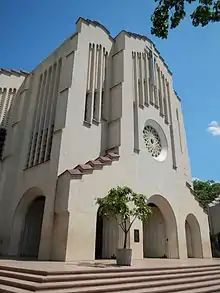
Our Lady of Perpetual Help is widely venerated by Filipino Catholics and Overseas Filipino communities. A German copy of the icon is venerated in the National Shrine of Our Mother of Perpetual Help in Baclaran, Parañaque City, Metro Manila – the country's centre of devotion to the icon. Pope John Paul II once offered a Catholic Mass at the shrine as cardinal, and later prayed before the icon during his first pastoral visit to the country in February 1981.[17]
Almost all Catholic churches and chapels in the Philippines have a replica of the icon, often enshrined in a side altar. Copies of the icon can also be found in countless houses, businesses, and even public utility vehicles.[18][19]
Every Wednesday, many congregations hold services where they publicly recite the rosary and the icon's associated novena, along with a priest delivering Benediction and celebrating a votive Mass in its honor. Devotees today still use the same Novena booklet first published by Irish Redemptorists, who introduced the icon and its devotion to the Philippines in the early 1900s. The Filipino Diaspora continue keeping the Wednesday Novena, holding novena services in their respective parishes overseas.[20][21]
In Saint John the Baptist Parish, Garcia Hernandez, Bohol, the feast of the image is held on April 27 instead of the usual liturgical date. The 48 sub-chapels in the parish participate in the annual feast, while every 27th month has each chapel's respective congregations holding a procession of the icon. This form of the devotion began in 1923 when two missionary priests, a Dutchman named Thomas and a German named Jorge, brought the icon to the town. The original icon can still be seen in a chapel of the parish; its reverse bears a Latin inscription attesting to its dedication.
In the province of Nueva Ecija, Our Lady of Perpetual Help is widely venerated. Yearly, a first class relic is exposed to the faithful from June 18 until June 27.
Patronage
The town of Almoradí (in the Valencian Country, Spain), invokes the patronage of Our Mother of Perpetual Help. In 1918, the son of Marquis of Rioflorido, Jose Carlos fell ill with pleurisy. His mother, the noble lady Desamparado Fontes fed him a silk fabric cloth touched to the icon of Perpetual Help in Rome which resulted in an instantaneous healing later claimed to be miraculous. As a token of thanksgiving, the lady Fontes officially donated funds to begin the Confraternity of Almoradí. On 29 May 1919, Our Lady of Perpetual Help was officially enthroned in Saint Andrew's Parish as the official patroness of the town. In 1945, Pope Pius XII confirmed this patronage by a pontifical decree. On its 50th anniversary in 1969, a public coronation of this image was held, directed by the town mayor and its authorities, with the crowns made by Santero artist Jose David.
In addition to this, Our Lady of Perpetual Help is designated the national patron saint of Haiti.[22] According to Roman Catholic Bishop Guy Sansaricq, former Haitian president Élie Lescot and his cabinet petitioned the Holy See to make Our Mother of Perpetual Help the national Patroness of Haiti in 1942.[23] Many Haitians credit the Virgin Mary under this title in performing miracles to prevent a smallpox outbreak which ravaged the country in 1882. The Holy See approved the request for patronage under the Pontificate of Pope Pius XII. The Our Lady of Perpetual Help is also present in numerous Haitian public stamps used by the Haitian postal office. In January 2010, Pope Benedict XVI invoked Our Lady of Perpetual Help for Haiti's earthquake relief through Archbishop Louis Kébreau.
Our Lady of Perpetual Help is also the patroness of the Diocese of Salina, Kansas in the United States,[24] of the Diocese of Middlesbrough in England, and of the Catholic Diocese of Issele-Uku in Nigeria.
Pope John Paul II issued a decree to crown a replica image in his personal name on 16 June 1999 for his native birth town of Wadowice, Poland.
Notable Parishes named in honor of Our Lady of Perpetual Help
_-_stained_glass%252C_Our_Lady_of_Perpetual_Help.jpg.webp)
- Basilica of Our Lady of Perpetual Help (Brooklyn, New York)
- Cathedral of Our Lady of Perpetual Help (Oklahoma City)
- Church of Our Lady of Perpetual Help and St. Alphonsus in the neighbourhood of Bella Vista, Montevideo, Uruguay
- Church of Our Lady of Perpetual Help and St Eugene in the zone of La Cruz de Carrasco, Montevideo, Uruguay
- Church of Our Lady of Perpetual Help in Tarnobrzeg in Serbinów, Poland
- Basilica of Our Lady of Perpetual Help (Boston, Massachusetts)
- Church of Saint Mary of Perpetual Help in Chicago, Illinois
- Our Lady of Perpetual Help Church (Glenview, Illinois, USA)
- Our Lady of Perpetual Help Church (Lautoka, Fiji Islands)
See also
Notes
- The Catholic Encyclopedia of 1911 uses the latter name: John Magnier, "Our Lady of Perpetual Succour" in Catholic Encyclopedia (New York 1911); but the former is more prevalent today.
References
- Festschrift zum Andenken an die Wiedereröffnung der St. Peters-Kirche, St. Peter's Church Philadelphia, 1901, page 93
- "Our Lady of Perpetual Help", Basilica of Our Lady of Perpetual Help, Brooklyn, New York
- "Types of Theotokos of the Passion". Bing.com. 2012-03-30. Retrieved 2014-01-26.
- Alfredo Tradigo. "Icons and saints of the Eastern Orthodox Church".
- Trinity Acres
- https://www.e-storieskritis.gr/2018/04/blog-post_22.html
- https://www.impeh.gr/wp-content/uploads/2020/05/proskynitarion.pdf
- http://nefeli.lib.teicrete.gr/browse/sdo/tour/2012/IoannouEvgenia/attached-document-1337582326-772867-3439/Ioannou2012.pdf
- Holy Monastery of Kera – Kardiotissa
- "Our Mother of Perpetual Help", The Redemptorists
- http://www.iconoflove.org/history-of-the-icon.html
- https://www.stmarysannapolis.org/about-church/history-of-st-marys
- "Who is Our Lady of Perpetual Help?". Aquinasandmore.com. Archived from the original on 2012-10-26. Retrieved 2014-01-26.
- "The History of the Icon". Cssr.com. Retrieved 2014-01-26.
- http://www.cssr.com/english/whoarewe/iconstory.shtml
- "Official Website of the Congregation of the Most Holy Redeemer. Superior General, Michael Brehl, C.SsR. - Latest Restoration of the Icon". Cssr.com. Retrieved 2014-01-26.
- "Vatican website: Pope John Paul II in the Philippines". Vatican.va. 1981-02-17. Retrieved 2014-01-26.
- Culture and Customs of the Philippines (Cultures and Customs of the World)
- Relations Between Religions and Cultures in Southeast Asia: Indonesian Philosophical Studies
- Asian American Religions: The Making and Remaking of Borders and Boundaries (Religion, Race, and Ethnicity)
- Religion at the Corner of Bliss and Nirvana: Politics, Identity, and Faith in New Migrant Communities
- "patrons of Haiti". Saints.sqpn.com. 2010-08-01. Retrieved 2014-01-26.
- "Haitians pray for perpetual help for their homeland 6/29/11 : Currents". Netny.net. 2011-06-29. Archived from the original on July 21, 2013. Retrieved 2014-01-26.
- "Salina Arms". salinadiocese.org. Retrieved 2018-06-28.
![]() This article incorporates text from a publication now in the public domain: Herbermann, Charles, ed. (1913). "Our Lady of Perpetual Succour". Catholic Encyclopedia. New York: Robert Appleton Company.
This article incorporates text from a publication now in the public domain: Herbermann, Charles, ed. (1913). "Our Lady of Perpetual Succour". Catholic Encyclopedia. New York: Robert Appleton Company.
Further reading
- Ferrero, Fabriciano. The Story of an Icon: The Full History, Tradition and Spirituality of the Popular Icon of Our Mother .., of Perpetual Help. Redemptorist Publications, 2001. ISBN 978-0-85231-219-3.
| Wikimedia Commons has media related to Our Lady of Perpetual Help. |